[游戏]组合塔防守2(Onslaught2)
Leandro Erlich

1973年出生于阿根廷的首都 Buenos Aires. 目前生活于Buenos Aires与巴黎之间。
Leandro Erlich 的艺术挑战了我们对真实的/现实的认知。他感兴趣的是我们每天看见的、我们生活在的、我们每天存在于的一切事物。他的认知是:我们承认所有的现实,因为我们假定一切现实存在着,而且这是真实的、是无法辩驳的东西…。他认为现实是我们承认的、是现实的的产物,最终,现实其实就是我们主要建筑的一切事物。
Erlich的艺术是建造观众可以走入的装置或一个物质的世界。他利用各种材料,如镜子或投影来创造现实的形式。他的作品以各种方式邀请我们参与,甚至可以和他的空间互动。这样,我们成为了他精心设计的舞台里的一个演员,从中感受半真半假的环境。这位来自阿根廷的艺术家把自己比作南美洲传统社会里的说书,他的讲述就如南美洲故事里的幻觉般。

1973年出生于阿根廷的首都 Buenos Aires. 目前生活于Buenos Aires与巴黎之间。
Leandro Erlich 的艺术挑战了我们对真实的/现实的认知。他感兴趣的是我们每天看见的、我们生活在的、我们每天存在于的一切事物。他的认知是:我们承认所有的现实,因为我们假定一切现实存在着,而且这是真实的、是无法辩驳的东西…。他认为现实是我们承认的、是现实的的产物,最终,现实其实就是我们主要建筑的一切事物。
Erlich的艺术是建造观众可以走入的装置或一个物质的世界。他利用各种材料,如镜子或投影来创造现实的形式。他的作品以各种方式邀请我们参与,甚至可以和他的空间互动。这样,我们成为了他精心设计的舞台里的一个演员,从中感受半真半假的环境。这位来自阿根廷的艺术家把自己比作南美洲传统社会里的说书,他的讲述就如南美洲故事里的幻觉般。
Swimming Pool
这个作品是erlich在休斯敦参与Core 项目时制作的。后来在2001 年的威尼斯的双年展上展出。





下图是在威尼斯展出的图片。


这个作品是erlich在休斯敦参与Core 项目时制作的。后来在2001 年的威尼斯的双年展上展出。





下图是在威尼斯展出的图片。


Smoking Room
2006



2006



Staircase 楼梯
2005



2005



The view
1997-2005





1997-2005





la plaza
2005


2005


Rain 雨
1999
第一次展出在2000年的惠特尼双年展。一个被隔成几面墙的展厅,每个墙上分别都有3个窗口,墙和墙之间营造出来的效果如两幢贴得很近的建筑,建筑之间是一场倾盆大雨,包括轰轰的雷雨声。仿佛观众透过窗口看到的就是真实生活中的雷雨。


1999
第一次展出在2000年的惠特尼双年展。一个被隔成几面墙的展厅,每个墙上分别都有3个窗口,墙和墙之间营造出来的效果如两幢贴得很近的建筑,建筑之间是一场倾盆大雨,包括轰轰的雷雨声。仿佛观众透过窗口看到的就是真实生活中的雷雨。


Piedras (invisible) 脚印 (隐形)
2002
启发于日本的禅意花园,这个装置的表面会不断浮起一双脚印,仿佛有个隐形人在上面行走。


2002
启发于日本的禅意花园,这个装置的表面会不断浮起一双脚印,仿佛有个隐形人在上面行走。


Le Cabinet Du PSY
2005



2005



El Ballet Studio
2002
这个作品首次展出于2002年的上海双年展。艺术家和3位样貌相似的太极拳演出者合作。他将展出空间隔成3个犹如3面镜子般的空间,空间的玻璃镜上看到的就如镜子的反映,观众被允许踏入这些空间感受奇怪的真实感。2003年这个作品也在巴塞罗那展出,展出的演员是几位芭蕾舞者。



2002
这个作品首次展出于2002年的上海双年展。艺术家和3位样貌相似的太极拳演出者合作。他将展出空间隔成3个犹如3面镜子般的空间,空间的玻璃镜上看到的就如镜子的反映,观众被允许踏入这些空间感受奇怪的真实感。2003年这个作品也在巴塞罗那展出,展出的演员是几位芭蕾舞者。



The Glass Shop
2005





2005





proyecto obelisco
1993



1993



Las Puertas
2004
首展于第26届圣保罗双年展。黑暗的空间内放置着一排并列的门。门的下方安装了明亮的日光灯,观众将误以为门里面的空间是明亮的,其实门的另一方和空间一样黑暗。


2004
首展于第26届圣保罗双年展。黑暗的空间内放置着一排并列的门。门的下方安装了明亮的日光灯,观众将误以为门里面的空间是明亮的,其实门的另一方和空间一样黑暗。


neighbors
1996




1996




El Living
1998


1998


El Ascensor
1995



1995



Batiment
2004



2004



La Torre
2002



2002



Turismo
2000




2000




El Pasillo
2007




2007




The room (surveillance 1)
2006



2006



eau molle
2003
这个作品参与了法国一个名为--《9月的春天》的项目。这个装置的概念是将法国的 Garonne 河迁移至展厅。整个装置由水和数码冲印组成,观众踏在装置上时,水纹将影响印刷布上的条纹。


2003
这个作品参与了法国一个名为--《9月的春天》的项目。这个装置的概念是将法国的 Garonne 河迁移至展厅。整个装置由水和数码冲印组成,观众踏在装置上时,水纹将影响印刷布上的条纹。


Toilette 厕所
2005
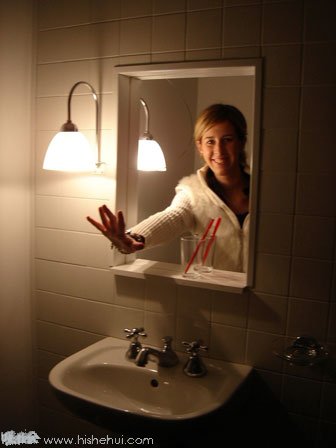
2005

很有意思
好作品,顶起来,
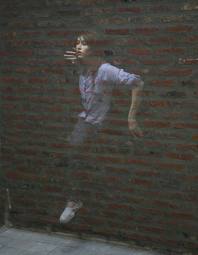
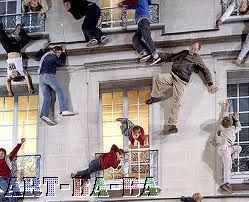

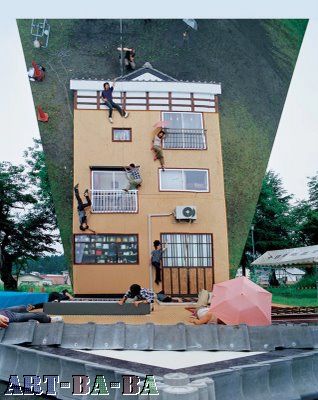

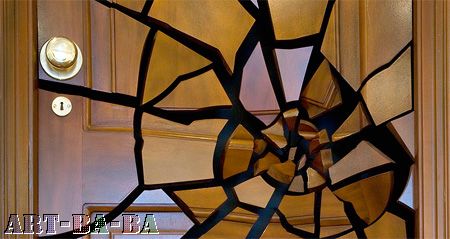

Leandro Erlich:
the world as reality and representationAWAKENING TO THE EVERYDAY
From the outside, the gallery appears completely empty. The light blue color of the walls is not very usual, nor is it something so extraordinary as to discourage entering. Strange reflections on the walls, a luminous and undulating reverberation suggests that there is still something to be revealed.
Perplexity is, perhaps, the first sensation that assaults us, as soon as we cross the threshold. To literally enter the confines of a pool is an experience that can produce ambiguous sensations, but surely nothing linked to our everyday behavior. After the initial shock, we are astonished by a mixture of wonder and alienation, of pleasure and stupor, which is difficult to put into words.
The experience of entering Leandro Erlich’s La Pileta [The Pool] (1999) is undoubtedly something that defies description in language. Despite being constructed like clockwork mechanisms, the works of this artist demand a first approach that is sensorial, immersive, that only later allows conceptual reflection or analysis on the mechanisms that produce this sense of alienation.
How is it possible not to evoke the oceanic sensation of the color-field paintings by Mark Rothko and Barnett Newman, that submission to the depths of aesthetic pleasure “here and now” that the latter fervently describes in his famous essay, “The Sublime is Now”? (2) . How not to recall the sensorial experiments of Robert Irwin or James Turrell, the representatives of that American West Coast minimalism that Rosalind Krauss characterized as “the Californian sublime”? (3)
In an article first published in the magazine Artforum, “The Sublime and the Avant-Garde”, the philosopher Jean-Francois Lyotard wonders, regarding the aforementioned essay by Newman: "How can one think of the sublime as a «Here» or a «Now»? Is not the sublime something, beyond normal experience, something that cannot be shown or presented?" (4) . His answer is that the experience of the “here and now”, which should be one of the most everyday experiences, is, in fact, completely unusual. Nothing is stranger today than the awareness of living “here and now”.
In Leandro Erlich’s works this awareness of the “here and now” greatly precedes its subsequent reception by the intellect. Even when in the end we discover the artifice, the magnificent trompe l’oeil that veils a reality that is perhaps no less illusory than the constructed one, there is an initial affirmation by the viewer in his own sensorial data that induces that “suspension of disbelief” that Borges demanded for the true work of art.
The effect of this initial shock deserves some commentary. Although it was criticized by Theodor Adorno in his Aesthetic Theory (5) owing to the danger of submerging the viewer in sensations that annul his critical awareness, Walter Benjamin hailed it as one of the most original contributions of film to contemporary artistic perception, an effect that continued the avant-garde practices of Dadaism (6) .
Nonetheless, our days are no longer that of Adorno or Benjamin, nor of Dadaism. The media culture in which we live has accustomed us to the effects of shock, which are apparent when sensationalism is resorted to as a means of attracting the masses. In this context, the initial perplexity that La Pileta provokes has a very different significance. Whereas the Dadaists resorted to shock in order to upset the commonplace, contemporary artists tend to resort to it in order to reaffirm everyday experience, in order to exalt that “here and now” that is so distant from daily consciousness. In both cases, as Fredric Jameson has pointed out, there is a disrealization of the world that entails a sharp reflection upon reality (7). But what is the reality to which a work like La Pileta refers?
In a series of radio interviews, Claude Lévy-Strauss noted how impressionism oriented toward landscape painting at the precise moment in which they were disappearing as a vital space for inhabitants of the growing urban centers of the nineteenth century (8). In La Pileta, the experience of leisure, the indulgence of the senses and the pleasure of enjoyment similarly constitute sensations that are removed from the lives of inhabitants of contemporary metropolises, a consequence of the deterioration of urban life so characteristic of postindustrial societies.
THE LIMIT AND BEYOND
From the interior of La Pileta, and above our heads, floats a watery film behind which a space of imprecise limits is perceived. This indeterminacy of boundaries, added to a series of playful inversions (interior/exterior, above/below, inside/outside), largely characterizes the work of Leandro Erlich.
The idea for the work was suggested by the guidelines for the contest itself. Those guidelines established the maximum dimensions for submissions which, in the case of objects, were 80 cm x 80 cm x 190 cm. Upon inquiring into the reasons for these specifications, Erlich got a very clear answer: they were the measurements of the elevator at the Fundación Banco Patricios building, the precise location where the award was to be presented. The work was already underway…
This story is revealing in more than one sense. Not only for the ingenuity with which the young artist literalized the arbitrariness of the allowed dimensions, but fundamentally because, inside the elevator, the work exceeded the limits through the specular effect of the mirrors. In this transgression of limits, the artist not only questioned the imposed rules but also the institutions that upheld them, opposing the freedom and imagination inherent to the act of artistic creation.
THROUGH THE LOOKING GLASS
Erlich’s attraction to optical effects attains a spectacular dimension in El Living [The Living Room] (1999). The installation consists of a living room whose wall contains two openings: one is a mirror that reflects the room while the other is a window that shows, in the other side, a room that is exactly the same but inverted, as if it were a mirror in which the image of the viewer does not appear. In contrast to La Pileta, in this work the shock effect is rather sinister. In the story “Tlön, Uqbar, Orbis Terius”, Jorge Luis Borges put an upsetting sentence into the mouth of his friend, Adolfo Bioy Casares: “mirrors and the copulation are abominable, because they increase the number of men” (9). What is so abominable about reproduction? What is so upsetting about this empty room that reproduces a universe to which we are denied access?
In literature and myths mirrors seem to be linked to two extreme and opposing circumstances that may be synthesized in the myth of Narcissus and the legend of Count Dracula. In the myth, Narcissus loses his life by falling in love with his own image; in the legend, the absence of a reflection characterizes the Count as a being without life who does not belong to mortal world. These two extremes confront us with death or, at least, with its representation. In his “Philosophical Enquiry into the Origin of Our Ideas of the Sublime and Beautiful”, Edmund Burke indicates the sense of self-preservation and the fear of death as the principal engines of the sublime (10). Confrontation with the disintegration of life induces a sensation that tends to confirm it, engendering the basis for our possible subliminal experience.
However, the uneasiness that this work provokes is not just limited to the absence of the mirror image, the one that constitutes the subject according to Lacanian theory. In addition, there is a tension between reality and representation - unfolded in a trompe l’oeil- that necessarily propose the instability of the world and an essential absence. “Instead of concerning for the essence of the model and its precise reconstruction -affirms Severo Sarduy- [the trompe l’oeil...] seems to be determined to produce its effect. And thereafter the strength of its subversion –to capture the surface, the skin, the outer wrapping, without passing through the central and founding, the Idea– and the aggressiveness aroused in the vindicators of essentialities by the strangeness of its theatricality that functions as if in a vacuum” (11). The vacuousness of this universe, represented as a mirror, points out to the latent vacuousness of that which serves as its model.
Sarduy continues: “This efficacy - that of making the non-existent visible - does not spring from the affirmation or apotheosis of a personality, of a style, but rather, on the contrary, from its maximum dissimulation, its cancellation: the more anonymous its execution and the less pronounced and visible its marks, the more effective the trompe l’oeil will be" (12). At the limits of deception, the work obviates its author, leaving the viewer before the upheaval of his perceptive universe. This latent depersonalization places Erlich in line with the Duchampian ready-made and its criticism of the author as the logical organizer of representation. As Hal Foster has stated referring to minimalist sculpture, “the death of the author is at the same time the birth of the viewer” (13), and in the end, he is the true target of El Living.
The discovery of the trick produces an alienation effect in the Brechtian sense of the term. The work reveals the mechanisms through which it produces its significance only to induce the viewer to reflect upon the ideological basis of reality, upon the devices that build it up, and upon the spectacularized world.
Beyond its prime meaning, El Living dramatizes what Jameson has characterized as the core of contemporary or post-industrial transnational societies: the fascination for reproduction machines which tend to reproduce everything, including the most immediate experiences (14). Nonetheless, Erlich avoids the mere surface of reproduction, in order to lead us towards a conscious examination of our surroundings. As in the case of Jeff Wall’s photography, the mise en scéne encourages to critically reconsider the links between reality and representation, to sharpen our perception of the spontaneous and to inquire into the foundations of the spectacle.
Still, there is another occasion for estrangement. As Lacan affirms: “the world is an omnivoyeur but it is not an exhibitionist: it does not provoke our gaze. When it begins to provoke it, then the sensation of alienation also begins” (15). The inverted room in The Living has an independent gaze from the viewer’s; that gaze preexists him and transforms him into an actor of the “spectacle of the world”, as stated by Merlau Ponty. This awareness of coexistence with another gaze is, perhaps, one of the more disturbing aspects of the piece.
The disarticulation of the gaze is also a constant in the work of the artist. In Vecinos [Neighbors] (1996), we are invited to peer through the eyehole of a door located in a 40 cm thick wall in order to observe what appears to be a corridor, several meters long, with doors, elevator, lights and even fire extinguishers. Our perception tricks us again. But at the same time, we are reminded that this entire theater exists only for the eye, the ultimate basis for the representation. The work presupposes a viewer who is also a voyeur. How can we not recall Marcel Duchamp’s Etánt Donnes in his appeal to the voyeurism of the viewer?
THEATER AND REAPPROPRIATION
Turismo [Tourism] (2000) was Leandro Erlich and Judi Werthein’s contribution to the Seventh Biennial of La Havana, organized under the slogan, “One closer to the other.” For many long days, a multitude of Cubans crowded before the installation in order to obtain a Polaroid photograph showing them in a snowy landscape, designed in the best Hollywood style.
In contrast to the previous works, here the staging is evident from the beginning. However, paradoxically, the artifice disappears at the end: the snowy photographs seem “real” or, in any case, they capture the prefabricated reality inherent to tourist pictures. But the main “realist” element of the piece was conceived by the participants themselves: a group of them came to the set with heavy clothing, despite the hot temperatures of the Cuban November, clearly exposing the high degree of participation that the works by Erlich arouse in his public.
Turismo excites a series of immediate interpretations. First, it introduces its participants to an experience to which few of them have access, not only because it does not snow in Cuba but moreover because the possibility of tourism is inaccessible for most of the population. Indeed, few people possess photographs inasmuch as the photographic mania of our capitalist societies is nonexistent on the island.
On the other hand, there is a reflection upon the way in which the media molds our relation to our surroundings. Photography - a producer of sensations that are so vivid that Walter Benjamin was moved to affirm that “the difference between the technique and magic is, of course, a historic variable” (16) - exists today almost exclusively in terms of technique, as a standardized format of experience. Little remains of the initial magic, apart from those Cubans who, with their own imaginations and dreams, transformed the initial proposal into living experience.
In Turismo we are acutely aware that the relations between man and his surroundings are not fixed, but rather that they can be constantly reinvented. We are confronted with the instability of experience but at the same time, with the possibility of reappropriating it in a concrete and creative way. The artist himself does so in each of his works, albeit at the cost of numerous struggles and difficulties: it is sufficient to recall one of his first projects – never completed – consisting in building a second obelisk in Buenos Aires, in the neighborhood of La Boca, similar to the one that exists in the center of the city, a project that sought to modify the urban configuration of our town.
Throughout his work, Leandro Erlich dramatizes his own nonconformist spirit, no longer that of the young revolutionaries of the sixties, but rather one that is perhaps more modest but no less effective, that refuses to accept reality as it is rigidly offered to contemporary man. In his pieces the boundaries between reality and representation are confused, but not only to denounce the insidious construction of reality, but also to indicate the real possibilities of reappropriating experience through representation. His works give rise to estrangement, uneasiness, astonishment, reticence, confusion, suspicion. But almost never to indifference.
the world as reality and representationAWAKENING TO THE EVERYDAY
From the outside, the gallery appears completely empty. The light blue color of the walls is not very usual, nor is it something so extraordinary as to discourage entering. Strange reflections on the walls, a luminous and undulating reverberation suggests that there is still something to be revealed.
Perplexity is, perhaps, the first sensation that assaults us, as soon as we cross the threshold. To literally enter the confines of a pool is an experience that can produce ambiguous sensations, but surely nothing linked to our everyday behavior. After the initial shock, we are astonished by a mixture of wonder and alienation, of pleasure and stupor, which is difficult to put into words.
The experience of entering Leandro Erlich’s La Pileta [The Pool] (1999) is undoubtedly something that defies description in language. Despite being constructed like clockwork mechanisms, the works of this artist demand a first approach that is sensorial, immersive, that only later allows conceptual reflection or analysis on the mechanisms that produce this sense of alienation.
How is it possible not to evoke the oceanic sensation of the color-field paintings by Mark Rothko and Barnett Newman, that submission to the depths of aesthetic pleasure “here and now” that the latter fervently describes in his famous essay, “The Sublime is Now”? (2) . How not to recall the sensorial experiments of Robert Irwin or James Turrell, the representatives of that American West Coast minimalism that Rosalind Krauss characterized as “the Californian sublime”? (3)
In an article first published in the magazine Artforum, “The Sublime and the Avant-Garde”, the philosopher Jean-Francois Lyotard wonders, regarding the aforementioned essay by Newman: "How can one think of the sublime as a «Here» or a «Now»? Is not the sublime something, beyond normal experience, something that cannot be shown or presented?" (4) . His answer is that the experience of the “here and now”, which should be one of the most everyday experiences, is, in fact, completely unusual. Nothing is stranger today than the awareness of living “here and now”.
In Leandro Erlich’s works this awareness of the “here and now” greatly precedes its subsequent reception by the intellect. Even when in the end we discover the artifice, the magnificent trompe l’oeil that veils a reality that is perhaps no less illusory than the constructed one, there is an initial affirmation by the viewer in his own sensorial data that induces that “suspension of disbelief” that Borges demanded for the true work of art.
The effect of this initial shock deserves some commentary. Although it was criticized by Theodor Adorno in his Aesthetic Theory (5) owing to the danger of submerging the viewer in sensations that annul his critical awareness, Walter Benjamin hailed it as one of the most original contributions of film to contemporary artistic perception, an effect that continued the avant-garde practices of Dadaism (6) .
Nonetheless, our days are no longer that of Adorno or Benjamin, nor of Dadaism. The media culture in which we live has accustomed us to the effects of shock, which are apparent when sensationalism is resorted to as a means of attracting the masses. In this context, the initial perplexity that La Pileta provokes has a very different significance. Whereas the Dadaists resorted to shock in order to upset the commonplace, contemporary artists tend to resort to it in order to reaffirm everyday experience, in order to exalt that “here and now” that is so distant from daily consciousness. In both cases, as Fredric Jameson has pointed out, there is a disrealization of the world that entails a sharp reflection upon reality (7). But what is the reality to which a work like La Pileta refers?
In a series of radio interviews, Claude Lévy-Strauss noted how impressionism oriented toward landscape painting at the precise moment in which they were disappearing as a vital space for inhabitants of the growing urban centers of the nineteenth century (8). In La Pileta, the experience of leisure, the indulgence of the senses and the pleasure of enjoyment similarly constitute sensations that are removed from the lives of inhabitants of contemporary metropolises, a consequence of the deterioration of urban life so characteristic of postindustrial societies.
THE LIMIT AND BEYOND
From the interior of La Pileta, and above our heads, floats a watery film behind which a space of imprecise limits is perceived. This indeterminacy of boundaries, added to a series of playful inversions (interior/exterior, above/below, inside/outside), largely characterizes the work of Leandro Erlich.
The idea for the work was suggested by the guidelines for the contest itself. Those guidelines established the maximum dimensions for submissions which, in the case of objects, were 80 cm x 80 cm x 190 cm. Upon inquiring into the reasons for these specifications, Erlich got a very clear answer: they were the measurements of the elevator at the Fundación Banco Patricios building, the precise location where the award was to be presented. The work was already underway…
This story is revealing in more than one sense. Not only for the ingenuity with which the young artist literalized the arbitrariness of the allowed dimensions, but fundamentally because, inside the elevator, the work exceeded the limits through the specular effect of the mirrors. In this transgression of limits, the artist not only questioned the imposed rules but also the institutions that upheld them, opposing the freedom and imagination inherent to the act of artistic creation.
THROUGH THE LOOKING GLASS
Erlich’s attraction to optical effects attains a spectacular dimension in El Living [The Living Room] (1999). The installation consists of a living room whose wall contains two openings: one is a mirror that reflects the room while the other is a window that shows, in the other side, a room that is exactly the same but inverted, as if it were a mirror in which the image of the viewer does not appear. In contrast to La Pileta, in this work the shock effect is rather sinister. In the story “Tlön, Uqbar, Orbis Terius”, Jorge Luis Borges put an upsetting sentence into the mouth of his friend, Adolfo Bioy Casares: “mirrors and the copulation are abominable, because they increase the number of men” (9). What is so abominable about reproduction? What is so upsetting about this empty room that reproduces a universe to which we are denied access?
In literature and myths mirrors seem to be linked to two extreme and opposing circumstances that may be synthesized in the myth of Narcissus and the legend of Count Dracula. In the myth, Narcissus loses his life by falling in love with his own image; in the legend, the absence of a reflection characterizes the Count as a being without life who does not belong to mortal world. These two extremes confront us with death or, at least, with its representation. In his “Philosophical Enquiry into the Origin of Our Ideas of the Sublime and Beautiful”, Edmund Burke indicates the sense of self-preservation and the fear of death as the principal engines of the sublime (10). Confrontation with the disintegration of life induces a sensation that tends to confirm it, engendering the basis for our possible subliminal experience.
However, the uneasiness that this work provokes is not just limited to the absence of the mirror image, the one that constitutes the subject according to Lacanian theory. In addition, there is a tension between reality and representation - unfolded in a trompe l’oeil- that necessarily propose the instability of the world and an essential absence. “Instead of concerning for the essence of the model and its precise reconstruction -affirms Severo Sarduy- [the trompe l’oeil...] seems to be determined to produce its effect. And thereafter the strength of its subversion –to capture the surface, the skin, the outer wrapping, without passing through the central and founding, the Idea– and the aggressiveness aroused in the vindicators of essentialities by the strangeness of its theatricality that functions as if in a vacuum” (11). The vacuousness of this universe, represented as a mirror, points out to the latent vacuousness of that which serves as its model.
Sarduy continues: “This efficacy - that of making the non-existent visible - does not spring from the affirmation or apotheosis of a personality, of a style, but rather, on the contrary, from its maximum dissimulation, its cancellation: the more anonymous its execution and the less pronounced and visible its marks, the more effective the trompe l’oeil will be" (12). At the limits of deception, the work obviates its author, leaving the viewer before the upheaval of his perceptive universe. This latent depersonalization places Erlich in line with the Duchampian ready-made and its criticism of the author as the logical organizer of representation. As Hal Foster has stated referring to minimalist sculpture, “the death of the author is at the same time the birth of the viewer” (13), and in the end, he is the true target of El Living.
The discovery of the trick produces an alienation effect in the Brechtian sense of the term. The work reveals the mechanisms through which it produces its significance only to induce the viewer to reflect upon the ideological basis of reality, upon the devices that build it up, and upon the spectacularized world.
Beyond its prime meaning, El Living dramatizes what Jameson has characterized as the core of contemporary or post-industrial transnational societies: the fascination for reproduction machines which tend to reproduce everything, including the most immediate experiences (14). Nonetheless, Erlich avoids the mere surface of reproduction, in order to lead us towards a conscious examination of our surroundings. As in the case of Jeff Wall’s photography, the mise en scéne encourages to critically reconsider the links between reality and representation, to sharpen our perception of the spontaneous and to inquire into the foundations of the spectacle.
Still, there is another occasion for estrangement. As Lacan affirms: “the world is an omnivoyeur but it is not an exhibitionist: it does not provoke our gaze. When it begins to provoke it, then the sensation of alienation also begins” (15). The inverted room in The Living has an independent gaze from the viewer’s; that gaze preexists him and transforms him into an actor of the “spectacle of the world”, as stated by Merlau Ponty. This awareness of coexistence with another gaze is, perhaps, one of the more disturbing aspects of the piece.
The disarticulation of the gaze is also a constant in the work of the artist. In Vecinos [Neighbors] (1996), we are invited to peer through the eyehole of a door located in a 40 cm thick wall in order to observe what appears to be a corridor, several meters long, with doors, elevator, lights and even fire extinguishers. Our perception tricks us again. But at the same time, we are reminded that this entire theater exists only for the eye, the ultimate basis for the representation. The work presupposes a viewer who is also a voyeur. How can we not recall Marcel Duchamp’s Etánt Donnes in his appeal to the voyeurism of the viewer?
THEATER AND REAPPROPRIATION
Turismo [Tourism] (2000) was Leandro Erlich and Judi Werthein’s contribution to the Seventh Biennial of La Havana, organized under the slogan, “One closer to the other.” For many long days, a multitude of Cubans crowded before the installation in order to obtain a Polaroid photograph showing them in a snowy landscape, designed in the best Hollywood style.
In contrast to the previous works, here the staging is evident from the beginning. However, paradoxically, the artifice disappears at the end: the snowy photographs seem “real” or, in any case, they capture the prefabricated reality inherent to tourist pictures. But the main “realist” element of the piece was conceived by the participants themselves: a group of them came to the set with heavy clothing, despite the hot temperatures of the Cuban November, clearly exposing the high degree of participation that the works by Erlich arouse in his public.
Turismo excites a series of immediate interpretations. First, it introduces its participants to an experience to which few of them have access, not only because it does not snow in Cuba but moreover because the possibility of tourism is inaccessible for most of the population. Indeed, few people possess photographs inasmuch as the photographic mania of our capitalist societies is nonexistent on the island.
On the other hand, there is a reflection upon the way in which the media molds our relation to our surroundings. Photography - a producer of sensations that are so vivid that Walter Benjamin was moved to affirm that “the difference between the technique and magic is, of course, a historic variable” (16) - exists today almost exclusively in terms of technique, as a standardized format of experience. Little remains of the initial magic, apart from those Cubans who, with their own imaginations and dreams, transformed the initial proposal into living experience.
In Turismo we are acutely aware that the relations between man and his surroundings are not fixed, but rather that they can be constantly reinvented. We are confronted with the instability of experience but at the same time, with the possibility of reappropriating it in a concrete and creative way. The artist himself does so in each of his works, albeit at the cost of numerous struggles and difficulties: it is sufficient to recall one of his first projects – never completed – consisting in building a second obelisk in Buenos Aires, in the neighborhood of La Boca, similar to the one that exists in the center of the city, a project that sought to modify the urban configuration of our town.
Throughout his work, Leandro Erlich dramatizes his own nonconformist spirit, no longer that of the young revolutionaries of the sixties, but rather one that is perhaps more modest but no less effective, that refuses to accept reality as it is rigidly offered to contemporary man. In his pieces the boundaries between reality and representation are confused, but not only to denounce the insidious construction of reality, but also to indicate the real possibilities of reappropriating experience through representation. His works give rise to estrangement, uneasiness, astonishment, reticence, confusion, suspicion. But almost never to indifference.